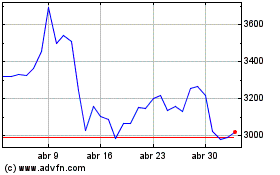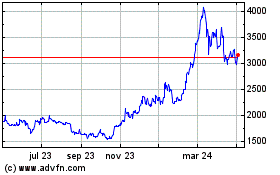Ethereum Seeing High Exchange Outflows, But Watch Out For This Bearish Signal
31 Julio 2024 - 11:30PM
NEWSBTC
On-chain data shows Ethereum has been observing high exchange
outflows recently, but a development related to Tether (USDT) may
be a bearish obstacle for the market. Ethereum And Tether Both Have
Seen Withdrawals From Exchanges Recently As explained by the
on-chain analytics firm Santiment in a new post on X, the market is
ending July on a mixed note in terms of the exchange flows. The
metric of interest here is the “Exchange Flow Balance,” which
measures the net amount of a given asset that’s entering into or
exiting the wallets associated with centralized exchanges. When the
value of this metric is positive, it means the inflows to these
platforms are outweighing the outflows right now. Such a trend
implies there is currently demand for trading away the asset among
the investors. Related Reading: XRP Bullish Signal: Shark &
Whale Population Sharply Growing On the other hand, the indicator
being negative implies the holders are making net withdrawals from
the exchanges, potentially holding onto their coins in the long
term. What implications either of these trends would have on the
wider market depends on the exact type of cryptocurrency the one in
question is: stablecoin or volatile asset. In the context of the
current topic, Santiment has cited the data for Ethereum and
Tether, which means both types of coins are relevant here. Below is
the chart shared by the analytics firm that shows the trend in the
Exchange Flow Balance for the two assets over the past few months:
As displayed in the above graph, the Exchange Flow Balance has
recently observed a sharp negative spike for both Ethereum and
Tether recently, implying that investors have been taking large
amounts of these coins off into self-custody. For volatile assets,
trading the asset away can have a negative effect on its price, so
the exchange reserve going up can be a bearish sign. The Exchange
Flow Balance being negative, on the contrary, can be bullish, as it
implies the potential “sell supply” of the coin is decreasing.
During the latest outflow spree, investors have withdrawn 80,763
ETH (almost $268 million) from these platforms, which is the
largest outflow spike in five months. Thus, Ethereum has seen its
sell supply go through a significant decline. In the case of
stablecoins, exchange inflows also mean the investors want to swap
the asset, but as these tokens have their value “stable” around the
$1 mark by definition, such trades have no effect on their price.
This doesn’t mean that they aren’t of any consequence to the
market, however, as investors usually use stables to buy a volatile
asset like Ethereum, so large exchange inflows of a stablecoin like
Tether can be bullish for these other coins. Related Reading:
Dogecoin & Other Memecoins Seeing Less Interest Than Bitcoin:
Data In this view, the exchange reserve of USDT and other stables
can be considered as a potential “buy supply” for the volatile
cryptocurrencies. Recently, USDT has seen net withdrawals of $346
million, meaning that this buy supply has gone down. “This reflects
less buying power for future purchases from traders, which is
generally a necessary ingredient needed to boost prices in the long
run,” notes Santiment. It now remains to be seen how the Ethereum
price will develop in the near future, given that both bullish and
bearish developments have simultaneously occurred in the market.
ETH Price At the time of writing, Ethereum is trading at around
$3,300, down more than 3% over the past week. Featured image from
Dall-E, Santiment.net, chart from TradingView.com
Ethereum (COIN:ETHUSD)
Gráfica de Acción Histórica
De Jul 2024 a Ago 2024

Ethereum (COIN:ETHUSD)
Gráfica de Acción Histórica
De Ago 2023 a Ago 2024
